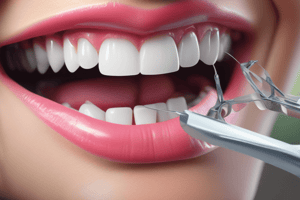Podcast
Questions and Answers
What classification system has the American College of Prosthodontists (ACP) developed?
What classification system has the American College of Prosthodontists (ACP) developed?
A classification system for the completely dentate, partially edentulous, and completely edentulous patient.
ACP Classification Benefits include improved _____ and improved professional _____ consistency.
ACP Classification Benefits include improved _____ and improved professional _____ consistency.
inter-operator consistency, communication
What is described as the physical state of the jaw following the removal of all erupted teeth?
What is described as the physical state of the jaw following the removal of all erupted teeth?
Complete edentulism.
The diagnostic criteria include ____ height, ____ relationship, ____ morphology, and ____ attachments.
The diagnostic criteria include ____ height, ____ relationship, ____ morphology, and ____ attachments.
Match the classification of the completely edentulous patient with their description:
Match the classification of the completely edentulous patient with their description:
Which type of Bone Height - Mandibular corresponds to 21mm or greater?
Which type of Bone Height - Mandibular corresponds to 21mm or greater?
What type of muscle attachment has high mentalis muscle attachment?
What type of muscle attachment has high mentalis muscle attachment?
What is a condition that can require pre-prosthetic surgery related to insufficient interarch space?
What is a condition that can require pre-prosthetic surgery related to insufficient interarch space?
A refractory patient continues to have chronic complaints despite appropriate therapy.
A refractory patient continues to have chronic complaints despite appropriate therapy.
What classification relationship requires tooth position outside normal ridge relation to attain phonetics and articulation?
What classification relationship requires tooth position outside normal ridge relation to attain phonetics and articulation?
The maxillomandibular relationship classification relates to the position of the artificial teeth to the _____ and to the _____.
The maxillomandibular relationship classification relates to the position of the artificial teeth to the _____ and to the _____.
What can raise the classification for a patient by one level?
What can raise the classification for a patient by one level?
Study Notes
ACP Classification Overview
- The American College of Prosthodontists (ACP) has a classification system for diagnosing and treating completely edentulous patients.
- This system is crucial for identifying conditions and treatment pathways for fully dentate and partially edentulous patients.
Benefits of ACP Classification
- Enhances inter-operator consistency among dental professionals.
- Improves professional communication across the dental field.
- Provides an objective method for patient screening, especially in dental education.
- Establishes standardized criteria for outcomes assessment and research.
- Increases diagnostic consistency and supports clinical decision-making during referrals.
Complete Edentulism Definition
- Refers to the condition of the jaw after all erupted teeth have been removed.
- Evaluates the state of supporting structures for reconstructive and replacement therapies.
Diagnostic Criteria Parameters
- Bone height: Mandibular measurements and morphology.
- Maxillo-mandibular relationship: Relationships of dental structures to jaw anatomy.
- Residual ridge morphology: Shape and support of the remaining jaw structure.
- Muscle attachments: Impact of muscle location on denture fit and function.
Classification of Completely Edentulous Patients
- Class I: Ideal or minimally compromised conditions.
- Class II: Moderately compromised conditions.
- Class III: Substantially compromised conditions.
- Class IV: Severely compromised conditions.
Mandibular Bone Height Types
- Type I: 21mm or greater.
- Type II: 16-20mm.
- Type III: 11-15mm.
- Type IV: 10mm or less.
Maxillary Residual Ridge Morphology Types
- Type A: Optimal support with well-defined anatomy; absence of tori/exostoses.
- Type B: Moderate compromise; rounded tori do not affect denture stability.
- Type C: Loss of vital vestibules; compromised support and minimal resistance to movement.
- Type D: Severe loss of structure with tori interfering with denture fit.
Muscle Attachments Types
- Type A: Adequate attached mucosa with no impingement during function.
- Type B: Adequate mucosal base except in the anterior buccal vestibule, affected by high mentalis muscle.
- Type C: Adequate mucosa with less support in anterior vestibules, influenced by high genioglossus and mentalis muscles.
- Type D: Adequate mucosal base only in the posterior lingual region; others are detached.
- Type E: No attached mucosa in any region, resulting in compromised denture retention.
Maxillomandibular Relationship Classes
- Class I: Normal articulation with residual ridge support.
- Class II: Tooth position outside normal ridge relation for phonetics and articulation.
- Class III: Crossbite scenario requires position adjustments beyond normal ridge relation.
Conditions Requiring Pre-Prosthetic Surgery
- Can be classified as minor or major for both soft and hard tissue procedures.
- Surgical correction necessary for issues like insufficient interarch space or large tongue obstructing space.
Refractory Patient Concept
- A patient with chronic complaints despite receiving appropriate therapy.
- Struggles to meet treatment expectations due to persistent challenges.
Guidelines for Classification System
- Mixed diagnostic criteria can elevate classification to a more complex category.
- Pre-treatment evaluations are advised for accurate classification; post-treatment analyses may alter final classification.
Additional Guidelines
- Patients classified under the highest checked category; reassessment is recommended after the removal of existing prostheses.
- Aesthetic concerns can raise classification by one level in Classes I and II.
Studying That Suits You
Use AI to generate personalized quizzes and flashcards to suit your learning preferences.
Description
This quiz focuses on the classification system developed by the American College of Prosthodontists (ACP) for diagnosing and treating completely edentulous patients. Key categories and diagnostic criteria will be explored in depth, enhancing understanding for dental professionals.





